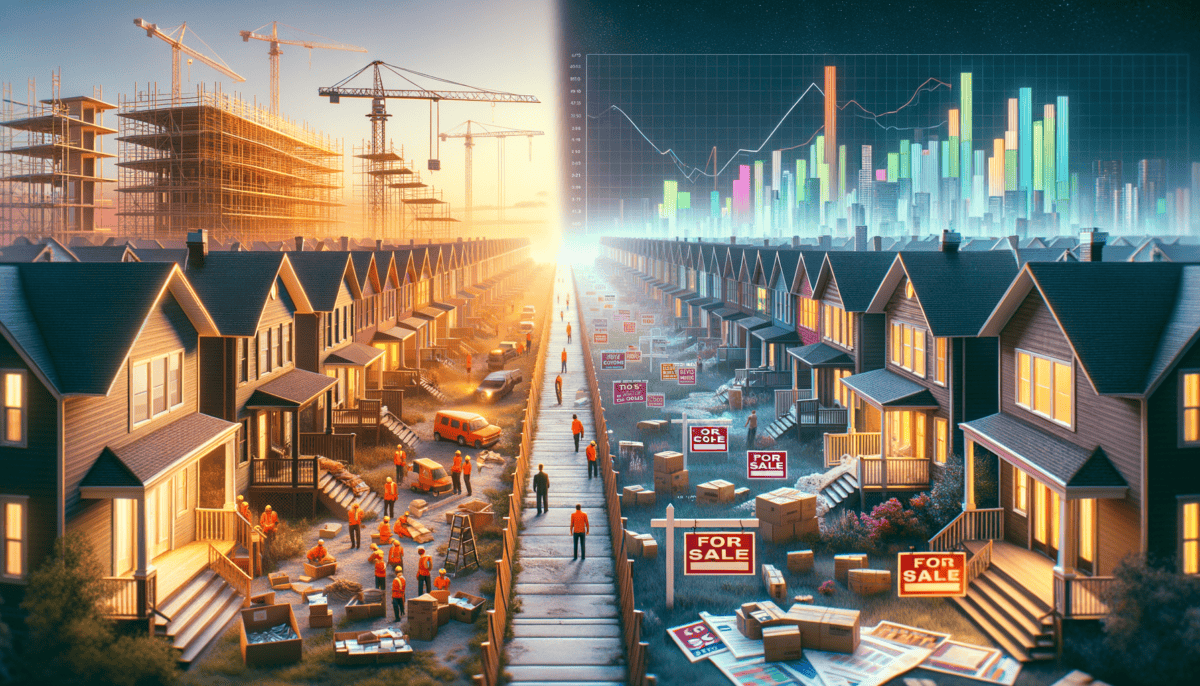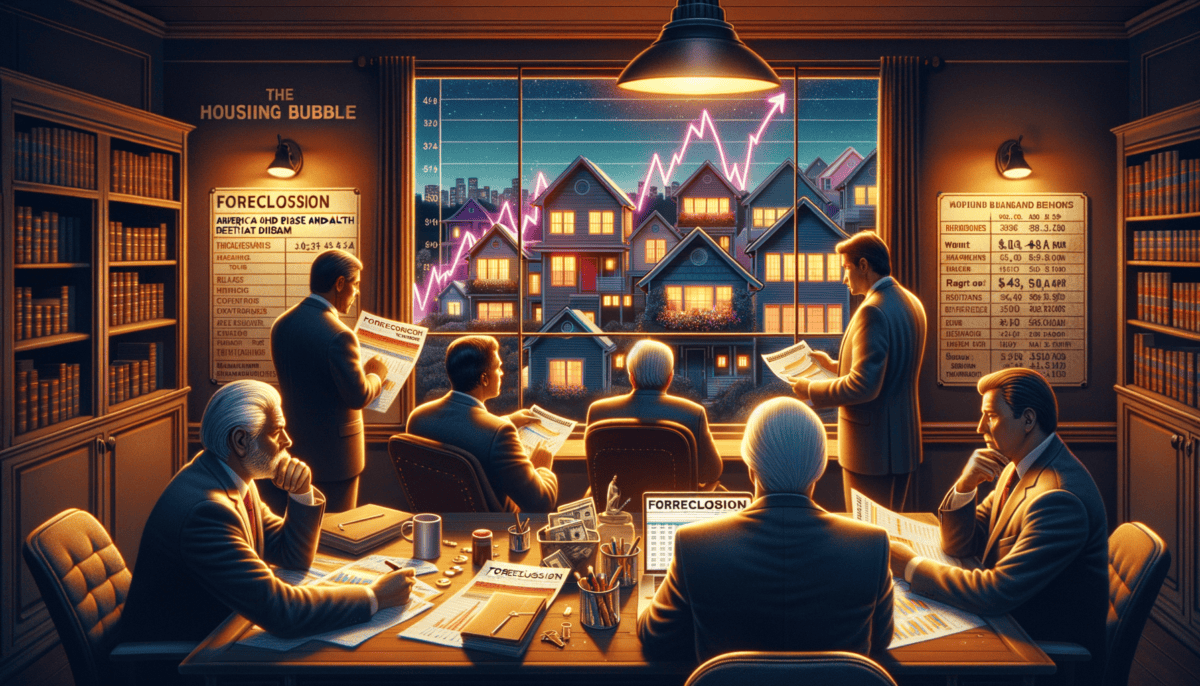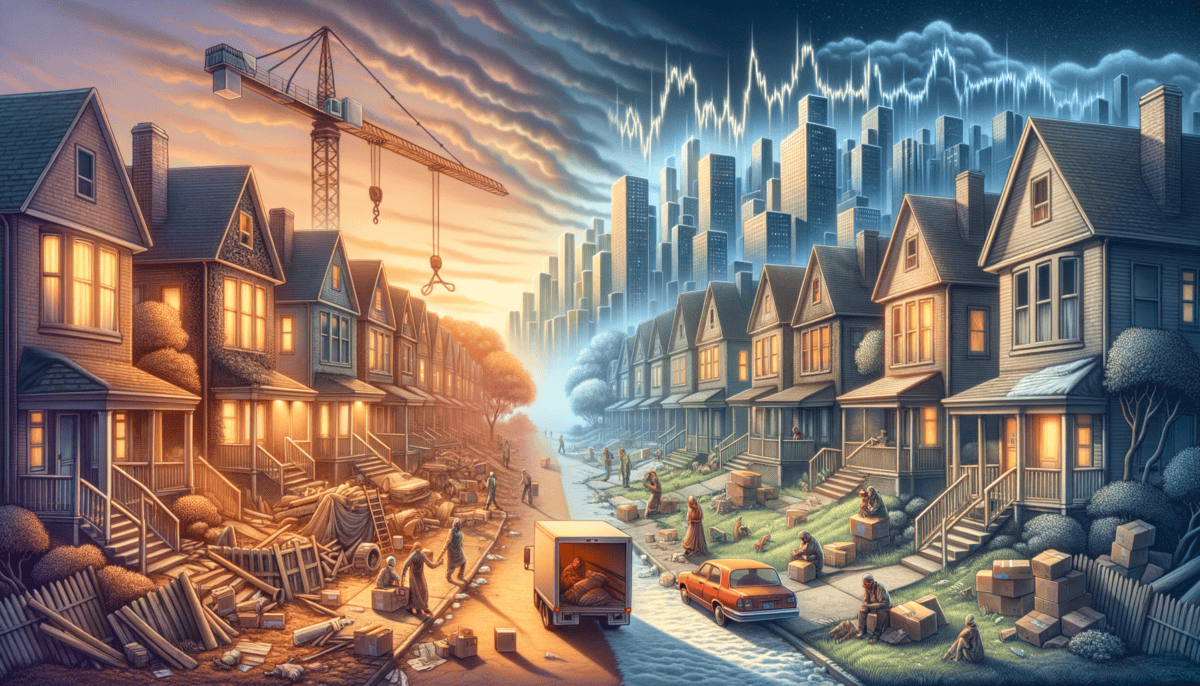A New Kind of American Dream
Meet Sarah and Tom Miller! They were just like you and me, living in a small apartment in 2001. Every day, they walked past beautiful houses and dreamed of having their own home.
"Honey, look at that house with the red door!" Sarah would say, pointing at her favorite one. "Wouldn't it be perfect for us?"
Tom would smile and squeeze her hand. "Maybe someday."
But that "someday" came sooner than they thought! The banks were saying something exciting – interest rates were super low. It was like getting a big discount on a house!
Money Was Easy to Get
Banks were being extra nice. They were giving out loans like candy on Halloween! Even people who didn't have perfect credit scores could get money to buy houses.
“It’s a whole new world,” their friend Mike, a banker, told them over coffee. “The rules have changed. Everyone can own a home now!”
The Millers weren't alone. All across America, people were getting excited about buying houses:
• House prices were going up fast
• Banks were saying "yes" to almost everyone
• Monthly payments seemed small and easy
• The economy was doing great
• Everyone thought house prices would keep rising forever
The Big Decision
Sarah and Tom sat at their kitchen table one night, looking at papers from the bank. Their hands were shaking with excitement.
"We can really do this?" Sarah whispered. "Our own home?"
Tom nodded. "The monthly payment is only a little more than our rent. And Mike says house prices are going up so fast, we'll make money just by living there!"
A Dream Come True
Two months later, Sarah and Tom were holding keys to their very own house. It had a pretty garden and three bedrooms – perfect for the family they hoped to start.
"Can you believe it?" Sarah danced around their empty living room. "Our very own house!"
But not everyone was dancing. Some smart people were worried. They saw something that most people didn't see yet.
Warning Signs
Dr. Johnson, an economics professor, was one of those worried people. He looked at all the houses being bought and all the money being borrowed.
"It's like building a tower of blocks," he told his students. "The higher it gets, the shakier it becomes."
But who wanted to listen to worried people when everything seemed so perfect? The Millers were happy in their new house. Their neighbors were happy in their new houses. Everyone was happy!
Little did they know that their American Dream was about to change in ways they never expected. The foundation of this dream house was not as solid as it seemed…
The Millers went to sleep that night in their new home, dreaming sweet dreams. The stars twinkled outside their window, and the future seemed bright and full of promise. But somewhere in the dark, storm clouds were gathering…
When Money Grew on Trees
By 2003, getting a house loan was easier than buying candy! Banks were saying “yes” to almost everyone who wanted money to buy a house.
“It’s amazing!” said Jack Wilson, a mortgage broker with a big smile. “I can get you a loan even if you don’t have much money saved up!”
The Magic Money Game
Banks came up with clever new ways to lend money. They called them “creative loans.” Here are some of their tricks:
• No money down needed!
• Super low payments for the first few years
• Pay only the interest, not the full loan
• No proof of income required
• Bad credit? No problem!
“These new loans are like magic!” Jack told his customers. “You can buy a bigger house than you ever thought possible!”
Meet the Johnson Family
The Johnsons were excited to hear about these new loans. They worked hard but didn’t make a lot of money.
“We can really buy a house?” Mrs. Johnson asked, her eyes wide.
“Of course!” Jack smiled. “Your payments will be very small for the first two years. Don’t worry about what happens after that – you can always sell the house for more money!”
The House-Flipping Game
Some people started buying houses just to sell them quickly for more money. They called it “flipping.”
“I bought this house last month for $200,000,” said Bob, a house flipper. “Now I’m selling it for $250,000! Easy money!”
More and more people wanted to play this game. They borrowed money to buy houses they didn’t plan to live in.
The Banks Get Greedy
The banks were making so much money from all these loans. They wanted more and more!
“We’ve never seen anything like this,” said Mary Thompson, a bank manager. “Everyone wants a loan, and house prices keep going up and up!”
But some wise people were getting worried. They saw that many people were borrowing more money than they could pay back.
“It’s like giving someone a bicycle with no brakes,” said Dr. Smith, a money expert. “It might be fun at first, but it could end badly.”
A Party That Couldn’t Last
By the end of 2004, the lending party was in full swing. Banks were lending more money than ever before. House prices were reaching for the sky.
The Johnsons moved into their dream house. Bob kept flipping houses. Jack kept writing more loans.
But underneath all the excitement, something was changing. Like a bubble getting bigger and bigger, the housing market was stretching thin.
Nobody wanted to think about what might happen if the bubble popped. They were too busy celebrating their new homes and dreaming of getting rich.
As the sun set on another busy day of buying and selling houses, nobody noticed the dark clouds gathering on the horizon. The biggest party in housing history was about to face its biggest test…
Castles Made of Sand
By 2005, houses were popping up everywhere like mushrooms after rain! ️ Builders couldn’t build new homes fast enough to keep up with all the people who wanted to buy them.
The Big Building Boom
“We’re building whole neighborhoods in just a few months!” said Tom Builder, wiping sweat from his forehead. His construction company was working day and night.
Empty fields turned into rows of shiny new houses. Old buildings came down to make way for fancy apartment towers reaching toward the sky. ️
Money in the Air
Wall Street (that’s where big money people work) got super excited about houses. They started treating houses like trading cards.
“Look at these numbers going up!” shouted Sarah, a Wall Street trader. “Everyone’s getting rich from houses!”
“It’s like a giant game of Monopoly, but with real houses and real money!” – Mike, Real Estate Investor
Meet the Sandcastle Family
The Sandcastles were regular folks who got caught up in the excitement. They owned three houses now!
“We live in one,” explained Mr. Sandcastle, “rent out another, and we’re fixing up the third one to sell it for more money.”
Mrs. Sandcastle nodded happily. “Our neighbors told us we were crazy not to buy more houses. The prices just keep going up!”
The Price is Wrong
Houses were getting so expensive that normal families could barely afford them. But nobody seemed worried because the banks kept lending money.
Here’s what happened to house prices in Happy Valley:
| Year | Price of Regular House |
|---|---|
| 2000 | $100,000 |
| 2005 | $400,000 |
The First Worried Voices
Some smart people started to worry. Dr. Wise, who studied money problems, shook her head when she looked at the numbers.
“Houses are like balloons now,” she said. “They’ve been blown up so big, they might pop!”
But most people didn’t want to listen to the worried voices. They were too busy dreaming about getting rich.
Signs of Trouble
Little problems started showing up:
• Some new houses were built so fast they had problems
• Empty houses sat waiting for buyers
• People started taking out bigger loans to pay for expensive houses
• Some folks couldn’t pay their house bills
The Party Keeps Going
Even with these problems, most people kept believing house prices would go up forever.
“Buy now or you’ll miss out!” became the favorite saying of house sellers. Everyone wanted to join the party before it was too late.
The Sandcastles and their neighbors kept celebrating their paper riches. But like sandcastles on the beach, their dreams were built on shaky ground.
As the summer of 2005 turned to fall, nobody could guess that their house of cards was about to meet a very strong wind…
When Dreams Start to Crumble
The year was 2006, and the first tiny cracks began to show in the great house party. Like ice cream left in the sun, things were starting to melt.
The Sandcastles Get Worried
Remember our friends, the Sandcastle family? They started having trouble with their three houses.
“The payments keep getting bigger,” whispered Mrs. Sandcastle to her husband one night. “And we can’t find anyone to rent our second house.”
Mr. Sandcastle frowned at the stack of bills. “Maybe buying three houses wasn’t such a good idea after all.”
Interest Rates Go Up
The banks had a surprise for everyone. They made the cost of borrowing money more expensive!
“It’s like when the price of ice cream goes up at the store,” explained Dr. Wise. “But this time, it’s the price of borrowing money that’s going up.”
The Phone Starts Ringing
Banks started calling people about their house payments:
| Before | After |
|---|---|
| Monthly Payment: $1,000 | Monthly Payment: $1,500 |
“How can we pay $500 more each month?” cried Sarah Thompson, a teacher. “That’s more than our food budget!”
Houses Start Getting Lonely
All those shiny new houses that builders made? Many sat empty, waiting for buyers who never came.
“I haven’t sold a house in two months,” said Tommy, a house seller. “Last year, I was selling three houses every week!”
The Smart People Speak Up
Some people who studied money started warning everyone:
• House prices can’t go up forever
• Many people borrowed too much money
• Banks made too many risky loans
• Trouble is coming
The First Dominoes Fall
Like dominoes lined up on a table, when one house price fell, others started falling too.
“My house is worth less than what I paid for it!” said Bobby, who bought his house last year. “That’s not supposed to happen!”
The News Gets Scary
TV news started talking about something called “foreclosures” – when banks take houses away from people who can’t pay their bills.
“More families are losing their homes every day,” reported Lisa News-Lady. “And no one knows when it will stop.”
Looking for Help
The Sandcastles and their neighbors started having emergency meetings.
“Maybe we can all help each other,” suggested Mrs. Friendly from next door. “We’re all in this together.”
But as winter came, more dark clouds gathered. The dream of easy money from houses was turning into a nightmare for many people.
And the worst was still to come…
When Everything Falls Apart
By 2007, the tiny cracks had turned into huge breaks. The house party wasn’t just ending – it was crashing down! ️
The Sandcastles Say Goodbye
The Sandcastle family had to make a hard choice. They couldn’t pay for their three houses anymore.
“We have to let the bank take two of our houses,” Mr. Sandcastle told his children. “But we’ll keep our main home.”
Little Tommy Sandcastle hugged his dad. “At least we still have each other.” ❤️
Banks Start to Wobble
Remember all those banks that gave out easy loans? Now they were in big trouble too!
“It’s like a game of musical chairs,” said Dr. Wise. “When the music stopped, lots of banks found themselves without a chair to sit on.”
The Stock Market Gets Scared
| Before Crisis | During Crisis |
|---|---|
| People’s savings: Growing | People’s savings: Shrinking |
“My retirement money is disappearing!” cried Mrs. Johnson, a retired teacher. “What will I do?”
Empty Houses Everywhere
Whole neighborhoods became ghost towns. Houses that once had happy families stood empty.
Some streets had signs that made everyone sad:
• Bank Owned
• Foreclosure
• For Sale
• Price Reduced
Jobs Start Disappearing
When houses stopped selling, lots of people lost their jobs:
“I used to build houses,” said Joe the Builder. “Now there’s no work for me.”
“My real estate office closed,” added Sally the House Seller. “Nobody’s buying anymore.”
Families Help Each Other
But in the middle of all this sadness, people started helping each other.
“You can stay with us until you find a new place,” Mrs. Friendly told the Thompsons, who lost their house.
“We’ll share our food,” said Mr. Kind to his neighbors. “We’re all family now.”
The Government Steps In
Finally, the government realized they needed to help. They started making plans to fix things.
“We need to stop this crisis,” said important people in Washington. “We can’t let more families lose their homes.”
Looking for Hope
As 2008 began, everyone wondered when things would get better.
“We’ve learned some hard lessons,” said Dr. Wise. “But sometimes we need to fall down to learn how to walk better.”
The housing bubble had burst, but something new was about to begin – the long road to making things right again…
Making Things Right Again
The sun rose on a new day in 2009. America was ready to fix its big housing problem!
The Helpers Arrive
President Obama and his team made a big plan. They wanted to help people keep their homes.
“We can’t let more families end up on the street,” the President said. “We need to help them stay in their houses.”
New Rules for Banks
“Banks need to be more careful now,” explained Dr. Wise. “They can’t give out loans to people who can’t pay them back.”
The government made new rules to keep banks safe:
• Check if people can really pay back loans
• No more tricky mortgage tricks
• Keep enough money in the bank
• Help people who are having trouble paying
Families Bounce Back
Remember the Sandcastle family? They got good news!
“The bank is helping us lower our monthly payments,” Mr. Sandcastle told his kids. “We can keep our home!”
| Before Help | After Help |
|---|---|
| High payments | Lower payments |
Communities Come Together
Neighbors helped each other more than ever:
“Let’s clean up these empty houses,” said Ms. Helpful. “We can make our street look nice again!”
“I’ll teach people about saving money,” offered Mr. Smart. “So this doesn’t happen again.”
Houses Become Homes Again
“Look, the Johnson family just moved in next door,” little Sally said. “I have new friends to play with!”
Learning Important Lessons
Dr. Wise gathered everyone to share what they learned:
“Sometimes houses are just for living in, not for getting rich quick.”
“It’s better to save money and be careful than to take big risks.”
“When we help each other, we all do better.” ❤️
A Brighter Future
By 2012, things were getting better. Houses were selling again, but this time people were smarter about buying them.
The housing bubble taught America some big lessons. People learned to be more careful with money and to help each other when times get tough.
Now when kids ask their parents about buying a house, they hear different advice:
“Save your money first, sweetie. A good home is worth waiting for.”
And that’s how America learned to make its housing dreams come true – the right way! ️






